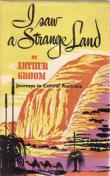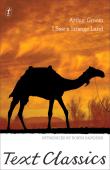AustLit
Latest Issues
AbstractHistoryArchive Description
'While living in Central Australia Arthur Groom fell under the spell of our harsh and fascinating country, captivated by its limitless distances and unbelievable colour. Hermannsburg, the home of artist Albert Namatjira and of other well-known painters, became Groom’s headquarters, and from there he made numerous expeditions into wilder and more inaccessible regions.
'Travelling on foot with an Indigenous guide and a team of camels, Groom explored the Macdonnell and Krichauff ranges, the desert country past the salty Lake Amadeus, Uluru and the Olgas. Based on the notes and photographs he took as he travelled, I Saw a Strange Land is Groom’s wonderful record of his extensive journey through the heart of our continent—our ‘strange land.’' (Publication summary)
Notes
-
Dedication: This book is dedicated to a great task which commenced at Bethany, at 4 p.m., on 22 October 1875.
Contents
Publication Details of Only Known VersionEarliest 2 Known Versions of
Works about this Work
-
Eerie Sounds, Then and Now: Listening In to Mid-Century Non-Indigenous Central Australian Soundscapes
2022
single work
criticism
— Appears in: Journal of Australian Studies , vol. 46 no. 2 2022; (p. 211-226) 'Mid-century non-Indigenous visitors to Central Australia such as the naturalist Hedley Finlayson (author of The Red Centre, 1935) and the journalist-cum-conservationist Arthur Groom (author of I Saw a Strange Land, 1950) wrote popular works that overturned prejudices about a “dead heart” and encouraged subsequent visitors and tourists. Yet they were often unsettled by eerie sounds. This article uses Mark Fisher’s notion of eeriness, as well as literature on the uncanny, to theorise the ambiguous sonic eerie. In particular, I show how, in the Australian settler-colonial context, the sonic eerie can prompt an unhomeliness that presences Indigenous dispossession or environmental degradation. In this way, it can undermine feelings of wonder and emplacement that other senses, including eyesight, might impart. But sonic eeriness need not always develop in that way, and it is often transient in its effects, even though it can result in echoes. While Finlayson and Groom overcame their unsettlement, part of the power that eeriness possesses is in the way in which those who read about it can also be affected by it. In these after-effects, we can still hear Indigenous claims to land being made, and the ghostly echoes of climate change.' (Publication abstract) -
Robyn Davidson Introduces I Saw a Strange Land
2015
essay
— Appears in: I Saw a Strange Land 2015; -
Strange Lands: The Lexicon of Settler-Colonial Landscapes in Charles Fletcher Lummis's and Arthur Groom's Portrayals of the American West and the Australian Outback
(International)
assertion
2015
single work
criticism
— Appears in: ISLE : Interdisciplinary Studies in Literature and Environment , vol. 22 no. 4 2015; (p. 697-716)
-
Strange Lands: The Lexicon of Settler-Colonial Landscapes in Charles Fletcher Lummis's and Arthur Groom's Portrayals of the American West and the Australian Outback
(International)
assertion
2015
single work
criticism
— Appears in: ISLE : Interdisciplinary Studies in Literature and Environment , vol. 22 no. 4 2015; (p. 697-716) -
Robyn Davidson Introduces I Saw a Strange Land
2015
essay
— Appears in: I Saw a Strange Land 2015; -
Eerie Sounds, Then and Now: Listening In to Mid-Century Non-Indigenous Central Australian Soundscapes
2022
single work
criticism
— Appears in: Journal of Australian Studies , vol. 46 no. 2 2022; (p. 211-226) 'Mid-century non-Indigenous visitors to Central Australia such as the naturalist Hedley Finlayson (author of The Red Centre, 1935) and the journalist-cum-conservationist Arthur Groom (author of I Saw a Strange Land, 1950) wrote popular works that overturned prejudices about a “dead heart” and encouraged subsequent visitors and tourists. Yet they were often unsettled by eerie sounds. This article uses Mark Fisher’s notion of eeriness, as well as literature on the uncanny, to theorise the ambiguous sonic eerie. In particular, I show how, in the Australian settler-colonial context, the sonic eerie can prompt an unhomeliness that presences Indigenous dispossession or environmental degradation. In this way, it can undermine feelings of wonder and emplacement that other senses, including eyesight, might impart. But sonic eeriness need not always develop in that way, and it is often transient in its effects, even though it can result in echoes. While Finlayson and Groom overcame their unsettlement, part of the power that eeriness possesses is in the way in which those who read about it can also be affected by it. In these after-effects, we can still hear Indigenous claims to land being made, and the ghostly echoes of climate change.' (Publication abstract)
- Northern Territory,






